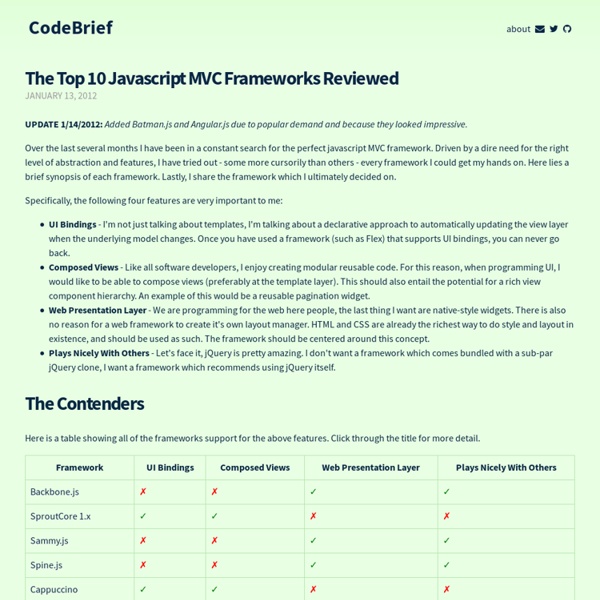



Spine Buyer Protection Program When you buy a domain name at Dan.com, you’re automatically covered by our unique Buyer Protection Program. Read more about how we keep you safe on our Trust and Security page. Next to our secure domain ownership transfer process, we strictly monitor all transactions. If anything looks weird, we take immediate action. Fast & easy transfers 98% of all domain ownership transfers are completed within 24 hours. Hassle free payments Pay by bank wire and get a 1% discount or use one of the most popular payment options available through our payment processor, Adyen. Microjs: Fantastic Micro-Frameworks and Micro-Libraries for Fun and Profit!
JSbooks - free javascript books - Iceweasel 15 Javascript Web UI Libraries, Frameworks and Toolkits :Speckyboy Design Magazine Almost all of the rich web applications that we currently see on the web today rely on a subtle set of UI controls, libraries or frameworks (or toolkits) that not only greatly simplify application development, they also provide a consistent, reliable, and highly interactive User Interface. What more could you ask for? Currently, there are a wide varied range of Web UI frameworks covering varied languages – for today we will focus on Javascript Web UI libraries. Not all libraries are suited for every project, but most developers will still rely on a single UI framework, a faithful friend they will always turn to in times of need… …so, if you are looking for a fresh UI outlook, below you will find the best 15 Javascript Web UIs, all offering, to different degrees, solutions. LivePipe: UI Components for Prototype LivePipe UI is a suite of widgets and controls for applications that has been built using the Prototype Javascript Framework. UKI – Simple UI Kit for Complex Web Apps jQuery UI Yahoo!
Composite JavaScript Applications With Backbone And Backbone.Marionette Although I’ve mentioned it in this blog already, and have been tweeting about it, we’ll call this the official announcement for my new Backbone.Marionette library. Backbone.Marionette: Make your BackboneJS apps dance with a composite application structure! Why? Over the last … however many months I’ve been using Backbone, I’ve developed a number of opinions around building apps. I have a particular style of code that I write, with a particular set of functionality that is common through most of (if not all of) my apps. To date, i have the following libraries for Backbone, with more ideas in my head based on the work I’m currently doing: My goal with these plugins is not to say “this is how you must work with Backbone”. The trick with my plugins, is to provide a set of libraries that all work independently, but can be combined in very creative ways to create some even more amazing. What? Application initializationView managementEvent aggregation How: Application Initialization But Wait!
Designing Javascript APIs We at Filepicker.io spend a lot of time thinking about APIs. With the release of our Version 1.0 javascript API, we thought about best practices for javascript API design, and wanted to share them so that when we use your API, it’ll be just as awesome as when you use ours. Rules of your Javascript API Rule 0: Never make breaking changes to your API. Unless you must. An API is a contract between you and the developers who use your product. The developers building on your API have invested time and energy into learning how to use your product and integrating it into theirs. However as your knowledge about how people are using your product and API grows, the original API will become stale and a refresh will be in order. Over the course of our early customer development during YC, the product and feature set was changing so fast it essentially meant we just piled more and more on to the API. Rule 1: Provide wood and nails, and a complete house for your API Use your API as you’re building it.
Scalable JavaScript Design Patterns Introduction Welcome to the resource page for my talk on Scalable JavaScript Design Patterns last presented at Web Directions (South). It's an extended version of the talk I gave at Fronteers and includes more information about a highly-decoupled architecture for building large applications I've been discussing recently. This version of the talk also covered live code demos of 'Aura', a framework based on some of the ideas in the presentation (see lower down for some code examples). Many of the concepts presented build upon previous work by Nicholas Zakas. I'm a firm believer in lowering the barrier of entry to (sometimes) complex concepts in JavaScript; this is one reason why the theme of my slides is 'Star Wars' and some of the initial concepts behind the design patterns used are explained through Star Wars metaphors. Notes In this talk, which expands on my earlier article, I describe a JavaScript application architecture that: Aura Code Samples todo-entry.js todo-counter.js Definitely.
JS: The Right Way - Iceweasel Stylus Simply require the module, and call render() with the given string of Stylus code, and (optional) options object. Frameworks utilizing Stylus should pass the filename option to provide better error reporting. We can also do the same thing in a more progressive manner: var stylus = require('stylus'); stylus(str) .set('filename', 'nesting.css') .render(function(err, css){ // logic }); .set(setting, value) Apply a setting such as a filename, or import paths: .set('filename', __dirname + '/test.styl') .set('paths', [__dirname, __dirname + '/mixins']) .include(path) A progressive alternative to .set('paths',...) is .include(). stylus(str) .include(require('nib').path) .include(process.env.HOME + '/mixins') .render(...) .import(path) Defer importing of the given path until evaluation is performed. .define(name, node) By passing a Node, we may define a global variable. However, this is not always available, so Nib may define: Stylus also casts JavaScript values to their Stylus equivalents when possible.